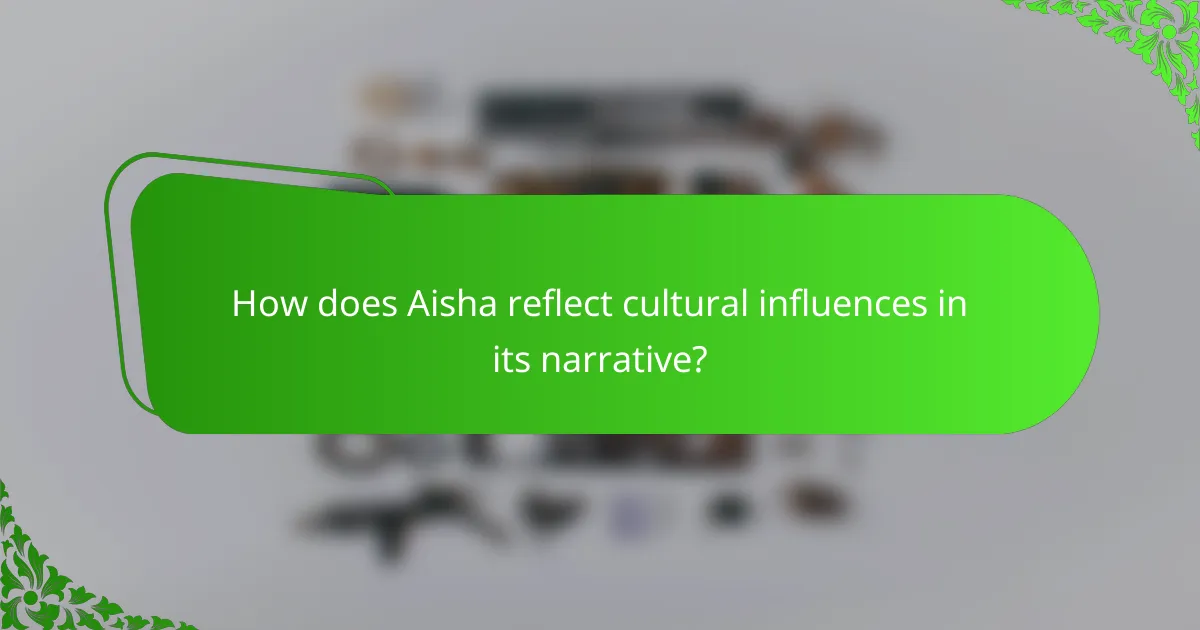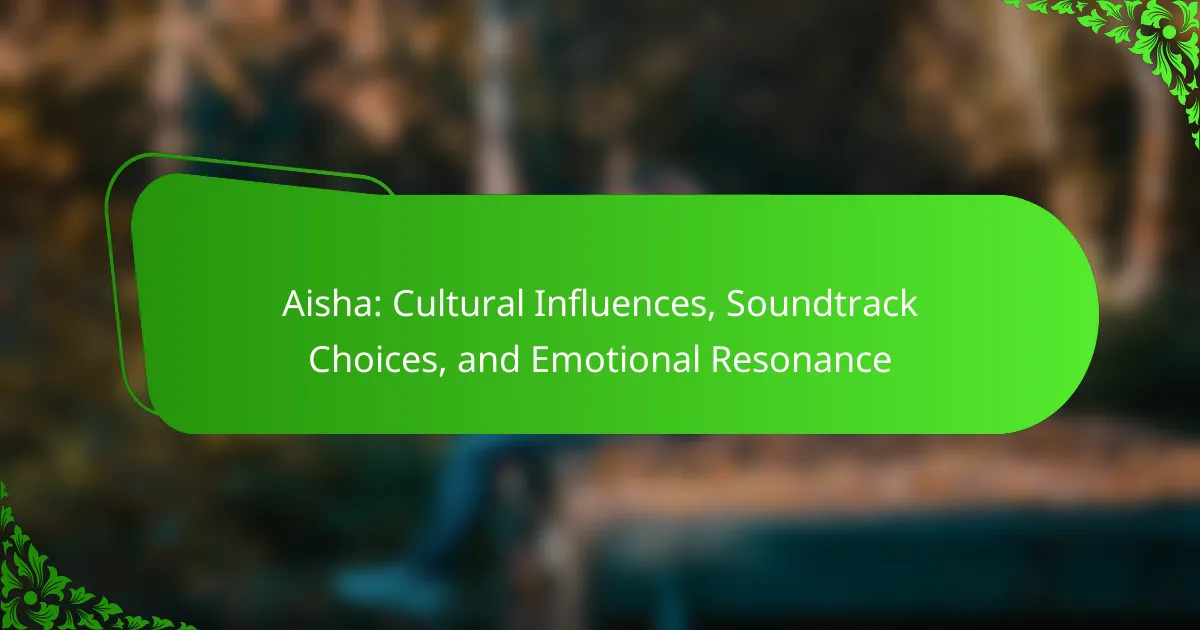Aisha’s narrative intricately weaves cultural influences into its character development and thematic exploration, drawing from diverse traditions to create a relatable tapestry of shared human experiences. The film’s carefully curated soundtrack enhances its emotional depth, blending regional music styles with contemporary sounds to forge a profound connection between the audience and the characters’ journeys.

How does Aisha reflect cultural influences in its narrative?
Aisha’s narrative embodies cultural influences through its rich character development, thematic depth, and setting, which draw from various traditions and societal contexts. This blend creates a tapestry that resonates with audiences by highlighting shared human experiences across different cultures.
Representation of diverse cultures
Aisha showcases a multitude of cultures by integrating characters and settings that reflect real-world diversity. This representation allows viewers to engage with different perspectives and traditions, fostering empathy and understanding. For instance, the film incorporates elements from South Asian, Middle Eastern, and Western cultures, illustrating the interconnectedness of these societies.
By using authentic dialogue, traditional attire, and culturally specific rituals, Aisha immerses the audience in a vibrant cultural landscape. This approach not only enriches the narrative but also encourages appreciation for the nuances of each culture represented.
Impact of historical events
The narrative of Aisha is deeply influenced by significant historical events that shape the characters’ lives and decisions. These events provide context for the struggles and triumphs depicted in the story, making it relatable to audiences familiar with similar historical contexts. For example, themes of migration and conflict are woven into the plot, reflecting real-life experiences faced by many communities.
By anchoring the story in historical realities, Aisha prompts viewers to reflect on the past’s impact on contemporary society. This connection encourages a dialogue about how history continues to influence cultural identities and relationships today.
Influence of traditional storytelling
Aisha draws heavily from traditional storytelling techniques, utilizing narrative structures and motifs that resonate across cultures. Elements such as the hero’s journey, moral lessons, and the use of folklore enhance the emotional depth of the film. These storytelling methods create a familiar framework that allows audiences to connect with the characters on a deeper level.
Incorporating traditional music and oral storytelling practices further enriches the viewing experience. This blend of modern cinematic techniques with age-old storytelling traditions not only honors cultural heritage but also makes the narrative accessible and engaging for a diverse audience.

What soundtrack choices enhance Aisha’s emotional depth?
The soundtrack of Aisha plays a crucial role in amplifying its emotional depth through carefully selected music that resonates with the film’s themes and characters. By blending regional music styles with contemporary artists, the soundtrack creates a rich auditory experience that deepens the audience’s connection to the narrative.
Use of regional music styles
Regional music styles are pivotal in establishing the cultural backdrop of Aisha. Incorporating traditional sounds and instruments not only grounds the film in its locale but also evokes specific emotions tied to the characters’ experiences. For instance, the use of folk melodies can enhance scenes of nostalgia or longing, making the emotional moments more impactful.
Additionally, integrating local rhythms and scales can help the audience feel the cultural nuances, fostering a deeper understanding of the characters’ motivations and struggles. This approach allows the film to resonate more authentically with viewers familiar with those musical traditions.
Integration of contemporary artists
Contemporary artists contribute a modern flair to Aisha’s soundtrack, bridging generational gaps and appealing to a wider audience. By featuring popular musicians, the film taps into current trends, making the emotional landscape relatable to younger viewers. This strategy can also introduce fresh interpretations of traditional themes, creating a dynamic listening experience.
Collaborations between established artists and emerging talents can further enrich the soundtrack. These partnerships often result in innovative sounds that blend various genres, enhancing the film’s emotional resonance while keeping it relevant in today’s music scene.
Soundtrack’s role in character development
The soundtrack significantly influences character development in Aisha by reflecting their inner thoughts and emotional journeys. Specific tracks can be associated with particular characters, allowing the audience to connect their emotional states with the music. For example, a character’s theme might evolve throughout the film, mirroring their growth or struggles.
Moreover, the strategic placement of songs during pivotal scenes can underscore character decisions and transformations. This technique not only heightens the emotional stakes but also helps the audience understand the characters’ motivations on a deeper level, making their journeys more compelling and relatable.

How does Aisha evoke emotional resonance with its audience?
Aisha evokes emotional resonance with its audience through relatable characters, impactful visual storytelling, and a carefully curated soundtrack. These elements work together to create a deep connection, allowing viewers to experience the characters’ journeys on a personal level.
Character relatability
The characters in Aisha are crafted to reflect real-life struggles and aspirations, making them relatable to a diverse audience. Viewers often see their own experiences mirrored in the characters’ challenges, fostering empathy and emotional investment. This relatability is enhanced by well-developed backstories that reveal their motivations and vulnerabilities.
For instance, Aisha’s journey of self-discovery resonates with many young adults navigating similar life transitions. By portraying authentic emotions and dilemmas, the film invites audiences to connect on a deeper level, enhancing the overall emotional impact.
Visual storytelling techniques
Aisha employs various visual storytelling techniques to enhance emotional engagement. Cinematic choices such as color palettes, camera angles, and lighting are used strategically to evoke specific feelings. For example, warm colors might be used during moments of joy, while cooler tones can signify conflict or sadness.
Additionally, the use of close-up shots allows viewers to see the characters’ expressions closely, amplifying emotional moments. These visual elements work in tandem to create a rich narrative experience that resonates with the audience’s emotions.
Audience engagement through music
The soundtrack of Aisha plays a crucial role in engaging the audience emotionally. Music is carefully selected to complement key scenes, enhancing the emotional weight of the narrative. For instance, uplifting tracks can elevate moments of triumph, while somber melodies underscore themes of loss or struggle.
Moreover, the integration of culturally relevant music helps to ground the film in its setting, making the emotional experiences more relatable to local audiences. By aligning the soundtrack with the film’s emotional arcs, Aisha effectively deepens the audience’s connection to the story and its characters.

What are the key cultural themes in Aisha?
Aisha explores several key cultural themes, including identity, family dynamics, and the tension between tradition and modernity. These themes resonate deeply with audiences, highlighting the complexities of navigating cultural expectations in contemporary society.
Identity and belonging
Identity and belonging are central themes in Aisha, reflecting the struggles individuals face in defining themselves within their cultural context. Characters often grapple with their heritage, seeking to balance personal desires with societal expectations.
This theme is particularly relevant in multicultural settings, where individuals may feel torn between different cultural identities. For instance, a character might embrace aspects of both their traditional upbringing and modern influences, creating a unique sense of self.
Family and community dynamics
Family and community dynamics play a crucial role in shaping the characters’ experiences in Aisha. The relationships between family members often illustrate the support and challenges that arise from close-knit communities. These dynamics can either strengthen bonds or create conflict, depending on how characters navigate their roles.
For example, a character’s decision to pursue a non-traditional career may lead to tension with family members who hold more conservative views. This conflict highlights the importance of communication and understanding in maintaining family ties while pursuing personal aspirations.
Tradition versus modernity
The tension between tradition and modernity is a recurring theme in Aisha, showcasing how characters confront and reconcile their cultural heritage with contemporary values. This theme often manifests in the choices characters make regarding lifestyle, relationships, and career paths.
For instance, a character may struggle with adhering to traditional customs while also wanting to embrace modern practices, such as dating outside their cultural group. This conflict illustrates the broader societal shifts occurring in many communities, where individuals seek to honor their roots while adapting to a changing world.

How do soundtrack choices influence viewer perception?
Soundtrack choices significantly shape viewer perception by evoking emotions and enhancing the narrative experience. The right music can create an atmosphere, influence mood, and even guide audience expectations throughout a film or show.
Emotional cues from music
Music serves as a powerful tool for conveying emotional cues, often setting the tone before any dialogue occurs. For instance, a suspenseful score can heighten tension, while a soft melody may evoke nostalgia or sadness. By aligning musical elements with visual storytelling, filmmakers can manipulate audience emotions effectively.
Using specific genres or instruments can also signal particular feelings. For example, orchestral arrangements often suggest grandeur or drama, while acoustic guitar may imply intimacy. Understanding these associations can help creators select soundtracks that resonate deeply with viewers.
Connection to cultural identity
Soundtrack choices can reflect and reinforce cultural identity, allowing audiences to connect with the narrative on a personal level. Incorporating traditional music or culturally significant instruments can evoke a sense of belonging and authenticity. This is particularly effective in films that explore cultural themes or settings.
For example, a film set in a specific region may use local folk music to enhance the viewer’s connection to the story. This not only enriches the viewing experience but also educates audiences about diverse cultures and traditions.
Impact on storytelling pace
The pace of a story can be significantly influenced by its soundtrack. Fast-paced music can accelerate the narrative, creating urgency during action scenes, while slower melodies can allow for reflection in quieter moments. This manipulation of tempo helps maintain audience engagement and emotional investment.
Filmmakers often use contrasting musical tempos to create dynamic shifts in storytelling. For instance, transitioning from a fast-paced score to a slow, somber piece can effectively signal a dramatic turning point. Understanding how to balance these elements is crucial for effective storytelling.

What frameworks can be used to analyze Aisha’s cultural impact?
To analyze Aisha’s cultural impact, frameworks such as cultural studies and media representation analysis provide valuable insights. These approaches help to understand how cultural narratives are constructed and the implications of their portrayal in various media.
Cultural studies approach
The cultural studies approach examines the ways in which Aisha reflects and shapes cultural identities. This framework considers factors such as race, gender, and class, and how they influence the narrative and character development. By analyzing these elements, one can uncover the underlying messages and values presented in Aisha.
Key aspects to consider include audience reception and the socio-political context in which Aisha is produced. Engaging with audience feedback and critiques can reveal how different demographics interpret the cultural themes within the work. This can lead to a deeper understanding of its impact on society.
Media representation analysis
Media representation analysis focuses on how Aisha is portrayed across various platforms and the implications of these portrayals. This framework assesses the accuracy and diversity of representations, highlighting whether they reinforce stereotypes or challenge societal norms. Analyzing character roles, story arcs, and visual elements can provide insights into the broader cultural narratives at play.
When conducting this analysis, consider the frequency and context of representation. For example, if Aisha features predominantly in positive roles, it may contribute to a more nuanced understanding of the cultural group it represents. Conversely, negative or one-dimensional portrayals can perpetuate harmful stereotypes, affecting public perception and cultural discourse.










